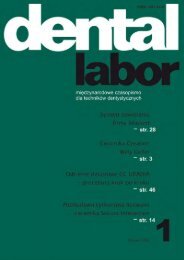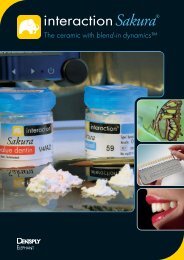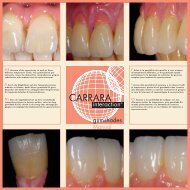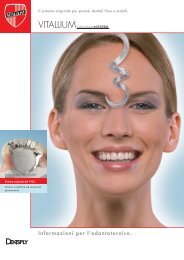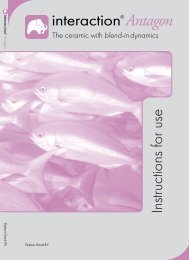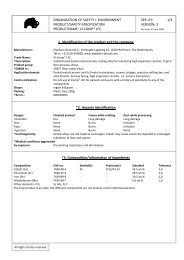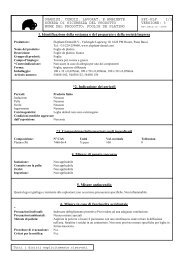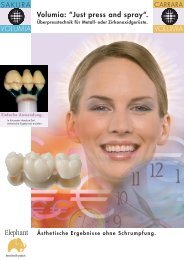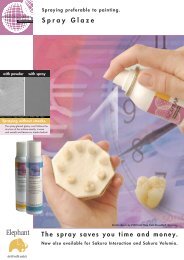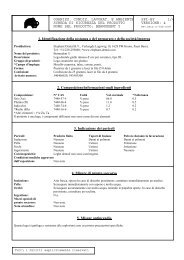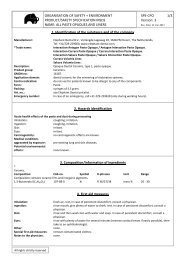Vitallium 2000 Investment - Elephant Dental
Vitallium 2000 Investment - Elephant Dental
Vitallium 2000 Investment - Elephant Dental
- No tags were found...
Create successful ePaper yourself
Turn your PDF publications into a flip-book with our unique Google optimized e-Paper software.
Mix investment and liquid thoroughlyand pour the mixture,carefully filling the ring.Transfer the case to a vibratingtable and allow the mold tovibrate until set (approximately15-20 minutes). After the<strong>Vitallium</strong> <strong>2000</strong> <strong>Investment</strong> hasset, remove it from the vibratingtable and allow it to set anadditional 30 minutes.5. Grind down the excess<strong>Vitallium</strong> <strong>2000</strong> <strong>Investment</strong> fromthe top of the case (rings) usinga model trimmer. Leave at least1 /2 inch of <strong>Vitallium</strong> <strong>2000</strong><strong>Investment</strong> above the highestpoint of the refractory model,and allow it to set an additionalone hour before burnout.Burnout and Casting1. Place the rings in a cool furnaceand heat to 1200˚F (649˚C)and hold for 30 minutes.2. Increase the furnace temperatureto <strong>2000</strong>˚F (1093˚C) andsoak for one hour.3. Remove rings from furnace andcast using V-<strong>2000</strong> or V-<strong>2000</strong>Plus alloy. Follow casting instructionsprovided for the alloy.4. Allow cases to bench cool priorto divesting. DO NOT WATERQUENCH.Physical PropertiesSetting Time: . . . . . . . . . 30 minutesCompressive Strength: . . . 2.3 MPaLinear Thermal Expansionat <strong>2000</strong>˚F . . . . . . . . . . . . . 1.50%WARNINGContains respirable crystalline silica (RCS). Do not breathedust. May cause delayed lung injury (silicosis,pneumoconiosis). The I.A.R.C. (International Agency forResearch on Cancer) reports (I.A.R.C. Monograph 68) thereis sufficient evidence in humans for the carcinogenicity ofinhaled crystalline silica in the forms of quartz or cristobalitefrom occupational sources. The NTP (National ToxicologyProgram) reports (Ninth annual report on Carcinogens) thatRCS is known to be a carcinogen based on sufficientevidence from studies in humans indicating a causalrelationship between exposure to RCS and increased lungcancer rates in workers exposed to crystalline silica dust.Follow OSHA Safety and Heath Standards for crystallinesilica. See Material Safety Data Sheet (MSDS) for detailedinformation.NPCAHMIS CODENOTEHealth3 Prolonged unprotectedoverexposure may result innonreversiblesilicosis. Sufficientevidence shows crystallinesilica causes cancer inhumans.Flammability 0 Non-flammableReactivity 0 Non-reactivePersonal Protection Use NIOSH/MSHA/*OSHA approvedrespirator.*DUSTRESPIRATORSee Material Safety Data Sheet(MSDS) for Detailed Information.3



